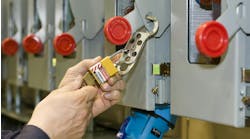The first choice when using a lift truck is often whether to use an LP gas truck or an electric one. Many people insist on electric because of the lower carbon footprint. This is a myth. The electric one has a much higher carbon footprint than the LP gas one unless the electric supply to the charging station comes from a nuclear-powered generating station. The lifetime carbon footprints of wind and solar are close to that of coal on a per kW-produced basis, so this factor is immaterial to your choice.
Let’s look at what does matter.
LP gas vs. electric
For many jobs, an electric lift truck just won’t do the job. That is especially true if the battery needs charging. Suppose your crew is replacing a distribution panel over the holiday when the plant is closed and there’s no lift truck operator. The plant engineer said for your crew to use any lift truck you wish. You fire up a gas-powered one, but don’t like the exhaust smell. So you get an electric one. As you’re moving the replacement panel up a ramp, the electric lift truck dies.
Plants that have gas-powered lift trucks also have ventilation. Like many plants, this one has forced-air ventilation. It’s just off over the holiday. Call the plant engineer, ask how to turn it on, and use the gas-powered lift truck to get the panel from the dead electric one.
Electric lift trucks don’t need the ventilation that gas-powered ones do, but gas-powered trucks don’t run out of juice and die going up a ramp due to the current drain imposed by the motor. The battery is both friend and foe.
Before using a gas truck check the:
- Ventilation in the area where it will be used.
- Gas reserve. If it’s low, get a fresh canister.
- Oil. If it’s low, you may burn up the engine and even start a fire. Low oil could mean the crankcase has a leak, and leaks create slipping hazards.
Before using an electric truck, check the battery. If it’s low, charge it or get a different truck. Also, look for a battery gauge visible to the driver. This is an important safety feature because not only can a low battery burn out the motor, but it is likely to result in battery failure. If the battery fails during use, the truck could be stuck on a ramp, across a traffic aisle, or across tracks used for automated equipment. Worse, the operator will lose control of the load.
Safety tips
Many of the safety rules are similar to those ignored by some people who drive cars:
- Always look in the direction you are going before moving the lift truck.
- Avoid left turns.
- Keep adequate distance between your truck and any vehicle or pedestrians in front of it.
- Yield the right of way to pedestrians and motor vehicles.
- Do not back into traffic, especially foot traffic.
- Do not pass pedestrians or other vehicles unless you can see clearly ahead of them.
- Follow site speed limits and other traffic regulations.
- Reduce speed for turns, especially if you are carrying a load
- If you must park the truck, don’t pull in headfirst. Back into the space so that you can easily see pedestrians when you pull out. Or park parallel to a wall or other structure.
- If you cannot see over the load and the forks or other lifting accessory is in front, drive backward.
- Slow down and sound your horn at cross aisles or when emerging from behind a wall or other visual obstacle.
- Tilt the load back before tackling a grade. If the grade is more than 10%, you must drive with the load facing the grade.
- As you approach where you need to stop, begin slowing down. Remember the load has momentum and you must allow for that.
- Cross railroad tracks diagonally to avoid getting the wheels stuck on the tracks.
- Before taking a load over bridge plates or grating, ensure those can handle the combined weight of the truck, driver, and load. If you aren’t sure, you can probably spread the weight adequately with a full sheet of plywood (at least 1/2 in; 3/4 is better).
- Before driving onto a tractor-trailer or other movable platform, ensure it is locked in place. There are specific techniques and specific devices for this purpose. If you are unfamiliar with these, don’t drive the truck across the platform as that could prove fatal to you and to the truck.
A couple of final cautions on electric lift trucks. Accelerate as you approach an upward incline such as a ramp between two floors that are of different heights. Use your horn to announce you are coming through. Consider asking a couple of operators or other people to act as crossing guards as you approach.
If you do get well up the ramp and the lift truck motor starts whining like it is really struggling or the truck just slows way down, don’t try your luck. Back it slowly down the ramp. Perhaps you can divide the load and make two or three trips or perhaps the truck’s battery is low. Trying to complete that ramp climb could deep-cycle the battery, causing it to lose half its capacity. Or you could burn up the motor, which means one less lift truck available and a big expense. But most of all, you risk dumping the load.




